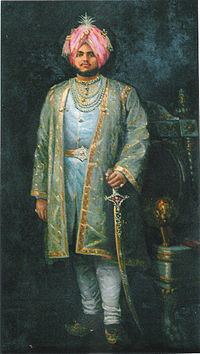1772–1947 → 1901 352 km (136 sq mi) | Flag Coat of arms Established 1772 1901 314,341 | |
 | ||
Kapurthala State, with its capital at Kapurthala, was a former Princely state of Punjab, spread across 352 square miles (910 km2).
Contents
According to the 1901 census the state had a population of 314,341 and contained two towns and 167 villages.
In 1930, Kapurthala became part of the Punjab States Agency and acceded to the Union of India in 1947.
History
The state was ruled by the Ahluwalia dynasty, founded in 1772 by Jassa Singh Ahluwalia (1718–1783), a prominent Sikh leader during the Sikh Confederacy, and also Misldar of the Ahluwalia army. He was born in village Ahlu or Ahluwal near Lahore, giving rise to the name of the family, Ahluwalia or one from Ahlu.
Badar Singh, the great-grandson of Sada Singh, married the daughter of a petty sardar of the district. Their son Jassa Singh Ahluwalia was born in 1718. Jassa Singh was barely five years old when his father died in 1723. Subsequently his mother requested Mata Sundri, the widow of Sikh Guru, Guru Gobind Singh to take care of young Jassa.
Upon growing up, she put him under the care of Sikh leader Nawab Kapur Singh. Jassa Singh soon rose in ranks and, on the eve of his death, Kapur Singh appointed him his successor in 1753. And after the capture of Lahore in 1761, Khalsa honored him with the title of Sultan-ul-Qaum (King of the whole people). He was the first one to take on the surname Ahluwalia (or Walia nowadays) and his followers use the surname Walia or Ahluwalia. He founded the state of Kapurthala in 1772, and his descendants remained powerful chiefs in Punjab until the rise of Ranjit Singh (1780–1839).
Jassa Singh had no male heir (two daughters) and, upon his death in 1783, he was cremated at Burj Baba Atal Sahib; he was succeeded by his cousin, Bhag Singh.
Maharaja Randhir Singh Bahadur got 700 mile square of area in Oudh by the British Government in year 1859. It was also known as Oudh Estate of Maharaja Kapurthala. The state was ruled by the Ahluwalia dynasty, founded in 1772 by Jassa Singh Ahluwalia (1718–1783), a prominent Sikh leader during the Sikh Confederacy, and also Misldar of the Ahluwalia army. He was born in village Ahlu or Ahluwal near Lahore, giving rise to the name of the family, Ahluwalia or one from Ahlu.[citation needed]
After the accession to India, Kapurthala State became a part of the Patiala and East Punjab States Union in 1948 and ceased to exist as a separate state.[3]
